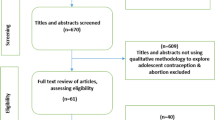Abstract
Most teens have regular access to the internet, and there is some expectation that the internet is helping to fill the sexual health information gap. We conducted in-depth interviews with a racially and ethnically diverse sample of 58 high school students to find out where they obtained information about contraception. A substantial minority had been exposed to online contraceptive information, but most did not consider it a main source. A majority had been exposed to this information from school, family, friends, and traditional media. Most teens were wary, or even distrustful, of online sexual health information, whereas school, family and, to a lesser extent, friends, were generally trusted. Our findings suggest that the internet is not filling the sexual health information gap for a number of teens, but we identify strategies that could increase teens awareness of, and trust in, information from this source.
Similar content being viewed by others
Notes
We generally assumed that interviewees' were referring to heterosexual, vaginal intercourse when they used the terms sex and sexual activity in regards to both their own behavior and that of others. However, we seldom clarified this definition. Several students referred or alluded to sexual activities other than vaginal intercourse (e.g., oral sex), but we did not probe their responses. Four students indicated that they were, or potentially were, gay, lesbian, or bisexual, and all related that they had not had sex; these individuals, in particular, may have been referring to sexual activities other than heterosexual vaginal intercourse.
References
Bess, K., Doe, K., Green, T., & Terry, T. (2009). Youth sexual health project: a framework for change. Retrieved November 15, 2010, from the David Catania website http://www.davidcatania.com/files/FINAL%20MERGED%20YSHP%20REPORT.pdf.
Borzekowski, D. L., & Rickert, V. I. (2001). Adolescent cybersurfing for health information: a new resource that crosses barriers. Archives of Pediatrics & Adolescent Medicine, 155, 813–817.
Braun-Courville, D. K., & Rojas, M. (2009). Exposure to sexually explicit websites and adolescent sexual attitudes and behaviors. The Journal of Adolescent Health, 45, 156–162.
Gilbert, L. K., Temby, J. R. E., & Rogers, S. E. (2005). Evaluating a teen STD prevention web site. The Journal of Adolescent Health, 37, 236–242.
Guilamo-Ramos, V., Dittus, P., Jaccard, J., Goldberg, V., Casillas, E., & Bouris, A. (2006). The content and process of mother–adolescent communication about sex in Latino families. Social Work Research, 30, 169–181.
Henry J. Kaiser Family Foundation (2003). National survey of adolescents and young adults: sexual health knowledge, attitudes and experiences. Retrieved on November 15, 2010, from the Kaiser Family Foundation website http://www.kff.org/youthhivstds/upload/National-Survey-of-Adolescents-and-Young-Adults.pdf.
Jaccard, J., Dittus, P. J., & Gordon, V. V. (2000). Parent–teen communication about premarital sex: factors associated with the extent of communication. Journal of Adolescent Research, 15(2), 187–208.
Jones, R.K. & Biddlecom, A.E. (2011). Is the internet filling the sexual health information gap for teens?: an exploratory study. Journal of Health Communication, 16, 112–123.
Lau, M., Markham, C., Lin, H., Flores, G., & Chacko, M. R. (2009). Dating and sexual attitudes in Asian–American adolescents. Journal of Adolescent Research, 24, 91–113.
Lindberg, L. D., Santelli, J. S., & Singh, S. (2006). Changes in formal sex education: 1995–2002. Perspectives on Sexual and Reproductive Health, 38, 182–189.
Martinez, G., Abma, J., & Copen, C. (2010). Educating teenagers about sex in the United States. NCHS data brief no. 44. Hyattsville: National Center for Health Statistics.
Miller, K. S., Kotchick, B. A., Dorsey, S., Forehand, R., & Ham, A. Y. (1998). Family communication about sex: what are parents saying and are their adolescents listening? Family Planning Perspectives, 30, 218–235.
Rideout, V. (2001). Generation Rx.com: how young people use the Internet for health information. Retrieved on November 15, 2010, from the Kaiser Family Foundation website http://www.kff.org/entmedia/loader.cfm?url=/commonspot/security/getfile.cfm&PageID=13719.
Suzuki, L., & Calzo, J. (2004). The search for peer advice in cyberspace: an examination of online teen bulletin boards about health and sexuality. Applied Developmental Psychology, 25, 685–698.
Wolak, J., Mitchell, K., & Finkelhor, D. (2007). Unwanted and wanted exposure to online pornography in a national sample of youth internet users. Pediatrics, 119, 247–257.
Ybarra, M. L., & Mitchell, K. J. (2005). Exposure to internet pornography among children and adolescents: a national survey. Cyber Psychology & Behavior, 8, 473–486.
Zhao, S. (2009). Parental education and children's online health information seeking: beyond the digital divide debate. Social Science & Medicine, 69, 1501–1505.
Acknowledgements
The authors thank Luciana Hebert and Ruth Milne for their substantive contributions to the project. We are also grateful to several school staff members (names purposely excluded to protect the identities of the schools) for their invaluable guidance and help with recruitment activities. This project was funded by a grant from the Ford Foundation.
Author information
Authors and Affiliations
Corresponding author
Additional information
Ann E. Biddlecom was formerly a Senior Research Associate at the Guttmacher Institute. The views expressed herein are those of the authors and do not necessarily reflect the views of the United Nations.
Rights and permissions
About this article
Cite this article
Jones, R.K., Biddlecom, A.E. The More Things Change…: The Relative Importance of the Internet as a Source of Contraceptive Information for Teens. Sex Res Soc Policy 8, 27–37 (2011). https://doi.org/10.1007/s13178-011-0039-0
Published:
Issue Date:
DOI: https://doi.org/10.1007/s13178-011-0039-0



